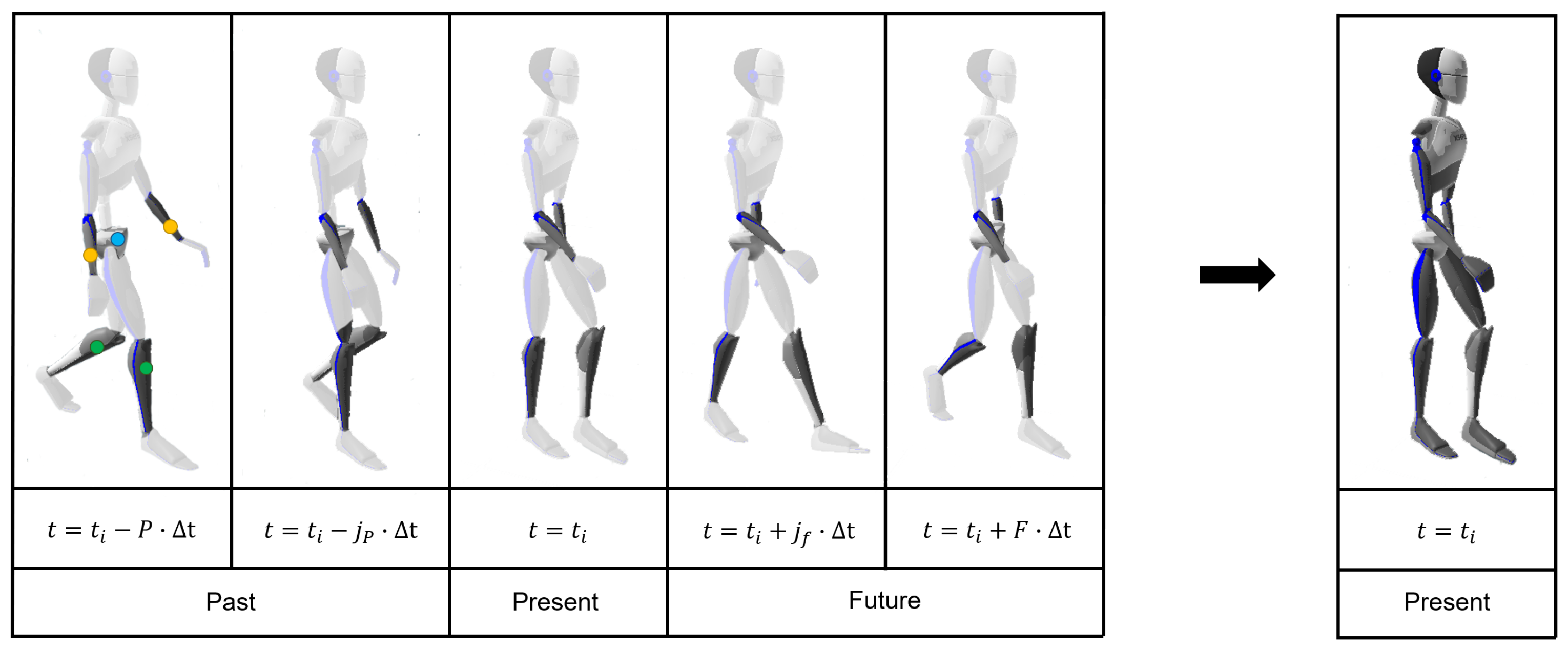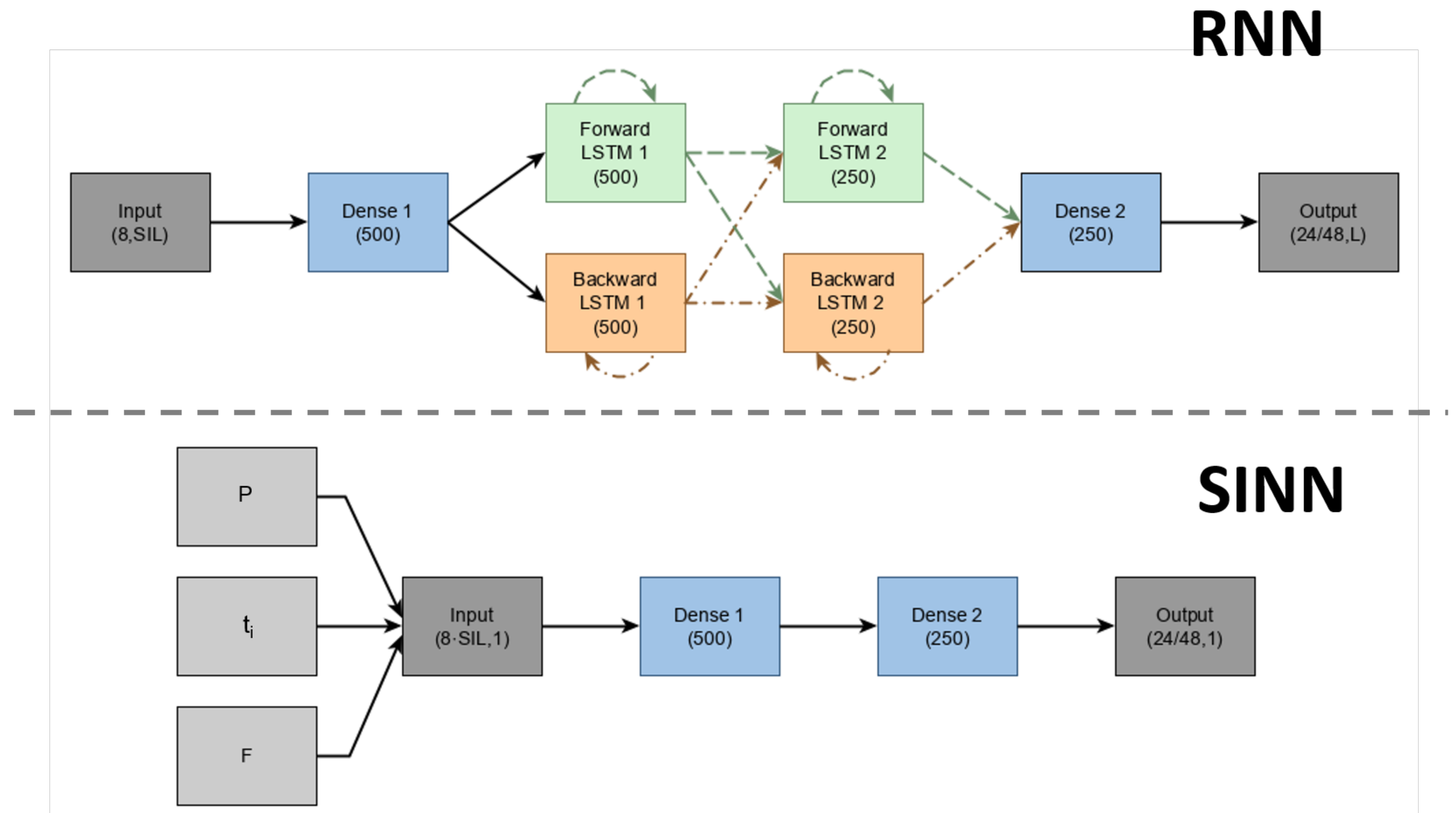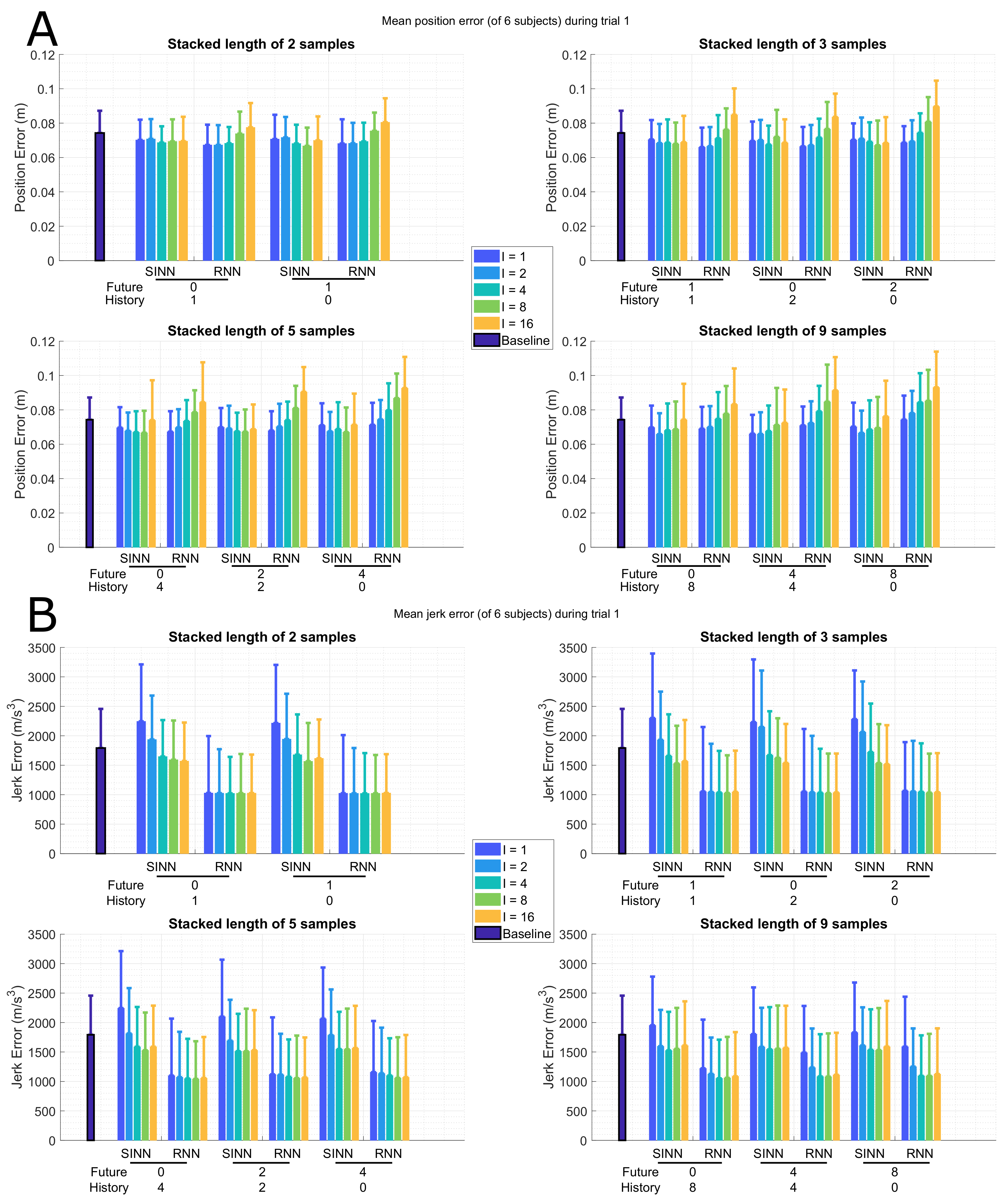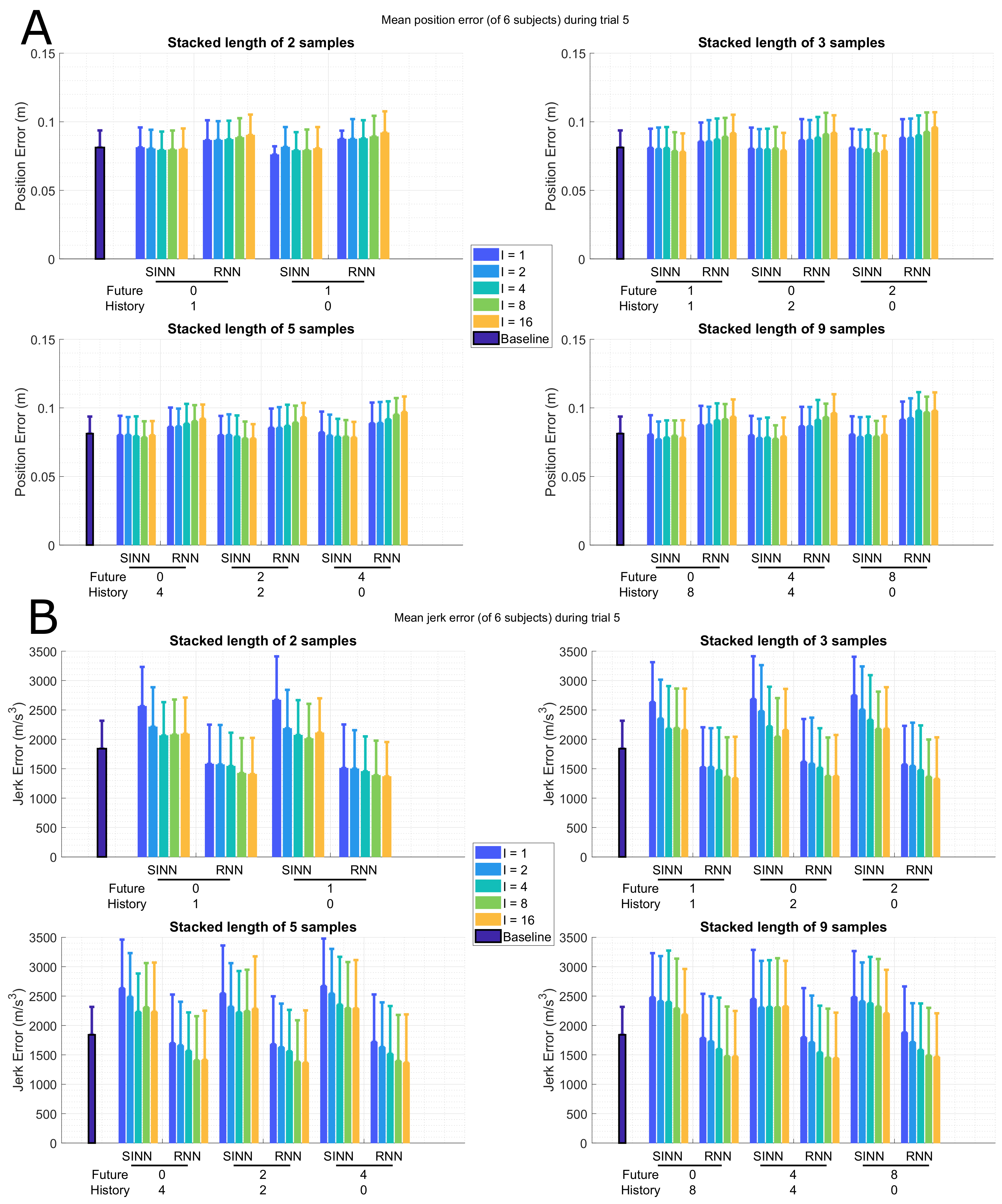Time Coherent Full-Body Poses Estimated Using Only Five Inertial Sensors: Deep versus Shallow Learning
Abstract
1. Introduction
2. Methods
2.1. Movement Dataset
2.2. Input Features
2.3. Stacked Inputs
2.4. Network Architecture
2.5. Performance Evaluation
3. Results
3.1. Time Window Configurations
3.2. Including Sensor Acceleration Features
3.3. Delay Assessment
4. Discussion
Future Work
5. Conclusions
Supplementary Materials
Author Contributions
Funding
Conflicts of Interest
Abbreviations
| ADL | Activities of Daily Living |
| ANN | Artificial Neural Network |
| IMU | Inertial Measurement Unit |
| LSTM | Long Short-Term Memory |
| RNN | Recurrent Neural Network |
| SIL | Stacked Input Length |
| SINN | Stacked Input Neural Network |
References
- Adesida, Y.; Papi, E.; McGregor, A.H. Exploring the role of wearable technology in sport kinematics and kinetics: A systematic review. Sensors 2019, 19, 1597. [Google Scholar] [CrossRef]
- Ancillao, A.; van der Krogt, M.M.; Buizer, A.I.; Witbreuk, M.M.; Cappa, P.; Harlaar, J. Analysis of gait patterns pre- and post- Single Event Multilevel Surgery in children with Cerebral Palsy by means of Offset-Wise Movement Analysis Profile and Linear Fit Method. Hum. Mov. Sci. 2017, 55, 145–155. [Google Scholar] [CrossRef] [PubMed]
- Karatsidis, A.; Bellusci, G.; Schepers, H.; de Zee, M.; Andersen, M.; Veltink, P. Estimation of Ground Reaction Forces and Moments During Gait Using Only Inertial Motion Capture. Sensors 2016, 16, 75. [Google Scholar] [CrossRef]
- Wouda, F.J.; Giuberti, M.; Bellusci, G.; Maartens, E.; Reenalda, J.; van Beijnum, B.J.F.; Veltink, P.H. Estimation of Vertical Ground Reaction Forces and Sagittal Knee Kinematics During Running Using Three Inertial Sensors. Front. Physiol. 2018, 9, 218. [Google Scholar] [CrossRef] [PubMed]
- Ancillao, A.; Tedesco, S.; Barton, J.; O’flynn, B. Indirect measurement of ground reaction forces and moments by means of wearable inertial sensors: A systematic review. Sensors 2018, 18, 2564. [Google Scholar] [CrossRef]
- Karatsidis, A.; Richards, R.E.; Konrath, J.M.; van den Noort, J.C.; Schepers, H.M.; Bellusci, G.; Harlaar, J.; Veltink, P.H. Validation of wearable visual feedback for retraining foot progression angle using inertial sensors and an augmented reality headset. J. NeuroEngineering Rehabil. 2018, 15, 78. [Google Scholar] [CrossRef]
- Cole, J.; Crowle, S.; Austwick, G.; Slater, D.H. Exploratory findings with virtual reality for phantom limb pain; from stump motion to agency and analgesia. Disability Rehabil. 2009, 31, 846–854. [Google Scholar] [CrossRef] [PubMed]
- Chanpimol, S.; Seamon, B.; Hernandez, H.; Harris-Love, M.; Blackman, M.R. Using Xbox kinect motion capture technology to improve clinical rehabilitation outcomes for balance and cardiovascular health in an individual with chronic TBI. Arch. Physiotherapy 2017, 7, 6. [Google Scholar] [CrossRef]
- Knippenberg, E.; Verbrugghe, J.; Lamers, I.; Palmaers, S.; Timmermans, A.; Spooren, A. Markerless motion capture systems as training device in neurological rehabilitation: A systematic review of their use, application, target population and efficacy. J. NeuroEngineering Rehabil. 2017, 14, 61. [Google Scholar] [CrossRef] [PubMed]
- Schepers, M.; Giuberti, M.; Bellusci, G. Xsens MVN: Consistent Tracking of Human Xsens MVN: Consistent Tracking of Human Motion Using Inertial Sensing; Xsens: Enschede, The Netherlands, 2018. [Google Scholar]
- Vicon Homepage. Available online: http://www.vicon.com/ (accessed on 1 April 2019).
- Qualisys Homepage. Available online: http://www.qualisys.com/ (accessed on 1 April 2019).
- MVN-Products-Xsens 3D Motion Tracking. Available online: https://www.xsens.com/products/xsens-mvn/ (accessed on 1 April 2019).
- Davis, R.B.; Õunpuu, S.; Tyburski, D.; Gage, J.R. A gait analysis data collection and reduction technique. Hum. Mov. Sci. 1991, 10, 575–587. [Google Scholar] [CrossRef]
- Sanger, T.D. Human arm movements described by a low-dimensional superposition of principal components. J. Neurosci. 2000, 20, 1066–1072. [Google Scholar] [CrossRef] [PubMed]
- Troje, N.F. Decomposing biological motion: A framework for analysis and synthesis of human gait patterns. J. Vision 2002, 2, 371–387. [Google Scholar] [CrossRef] [PubMed]
- Safonova, A.; Hodgins, J.K.; Pollard, N.S. Synthesizing physically realistic human motion in low-dimensional, behavior-specific spaces. ACM Trans. Graph. 2004, 23, 514. [Google Scholar] [CrossRef]
- Chai, J.; Hodgins, J.K. Performance animation from low-dimensional control signals. ACM Trans. Graph. 2005, 24, 686. [Google Scholar] [CrossRef]
- Slyper, R.; Hodgins, J.K.; Slyper, R.; Hodgins, J. Action capture with accelerometers. In Proceedings of the ACM SIGGRAPH/Eurographics Symposium on Computer Animation, Dublin, Ireland, 7–9 July 2008; pp. 193–199. [Google Scholar]
- Tautges, J.; Zinke, A.; Krüger, B.; Baumann, J.; Weber, A.; Helten, T.; Müller, M.; Seidel, H.P.; Eberhardt, B. Motion Reconstruction Using Sparse Accelerometer Data. ACM Trans. Graph. 2011, 30, 18:1–18:12. [Google Scholar] [CrossRef]
- Aha, D.W. Lazy learning. Artif. Intell. Rev. 1997, 11, 7–10. [Google Scholar] [CrossRef]
- Hettinger, L.J.; Riccio, G.E. Visually Induced Motion Sickness in Virtual Environments. Presence Teleoperators Virtual Environ. 1992, 1, 306–310. [Google Scholar] [CrossRef]
- Golding, J.F. Motion sickness susceptibility. Auton. Neurosci. 2006, 129, 67–76. [Google Scholar] [CrossRef]
- Wouda, F.J.; Giuberti, M.; Bellusci, G.; Veltink, P.H. Estimation of Full-Body Poses Using Only Five Inertial Sensors: An Eager or Lazy Learning Approach? Sensors 2016, 16, 2138. [Google Scholar] [CrossRef]
- Xiang, Y.; Chung, H.J.; Kim, J.H.; Bhatt, R.; Rahmatalla, S.; Yang, J.; Marler, T.; Arora, J.S.; Abdel-Malek, K. Predictive dynamics: An optimization-based novel approach for human motion simulation. Struct. Multi. Optim. 2010, 41, 465–479. [Google Scholar] [CrossRef]
- Von Marcard, T.; Rosenhahn, B.; Black, M.J.; Pons-Moll, G. Sparse Inertial Poser: Automatic 3D Human Pose Estimation from Sparse IMUs. Comput. Graph. Forum 2017, 36, 349–360. [Google Scholar] [CrossRef]
- Fragkiadaki, K.; Levine, S.; Felsen, P.; Malik, J. Recurrent Network Models for Human Dynamics. In Proceedings of the 2015 IEEE International Conference on Computer Vision (ICCV), Santiago, Chile, 7–13 December 2015; IEEE Computer Society: Washington, DC, USA, 2015; pp. 4346–4354. [Google Scholar]
- Tran, D.; Bourdev, L.; Fergus, R.; Torresani, L.; Paluri, M. Learning Spatiotemporal Features with 3D Convolutional Networks. In Proceedings of the 2015 IEEE International Conference on Computer Vision (ICCV), Santiago, Chile, 7–13 December 2015; IEEE Computer Society: Washington, DC, USA, 2015; pp. 4489–4497. [Google Scholar]
- Rambach, J.R.; Tewari, A.; Pagani, A.; Stricker, D. Learning to Fuse: A Deep Learning Approach to Visual-Inertial Camera Pose Estimation. In Proceedings of the 2016 IEEE International Symposium on Mixed and Augmented Reality (ISMAR), Merida, Mexico, 19–23 September 2016; pp. 71–76. [Google Scholar]
- Huang, Y.; Kaufmann, M.; Aksan, E.; Black, M.J.; Hilliges, O.; Pons-Moll, G. Deep Inertial Poser: Learning to Reconstruct Human Pose from Sparse Inertial Measurements in Real Time. ACM Trans. Graph. 2018, 37, 185:1–185:15. [Google Scholar] [CrossRef]
- Wouda, F.J.; Giuberti, M.; Bellusci, G.; Maartens, E.; Reenalda, J.; Van Beijnum, B.F.; Veltink, P.H. On the Validity of Different Motion Capture Technologies for the Analysis of Running. In Proceedings of the 7th IEEE International Conference on Biomedical Robotics and Biomechatronics (Biorob), Enschede, The Netherlands, 26–29 August 2018; pp. 1175–1180. [Google Scholar]
- Stief, F.; Böhm, H.; Michel, K.; Schwirtz, A.; Döderlein, L. Reliability and Accuracy in Three-Dimensional Gait Analysis: A Comparison of Two Lower Body Protocols. J. Appl. Biomech. 2013, 29, 105–111. [Google Scholar] [CrossRef]
- Ferrari, A.; Benedetti, M.G.; Pavan, E.; Frigo, C.; Bettinelli, D.; Rabuffetti, M.; Crenna, P.; Leardini, A. Quantitative comparison of five current protocols in gait analysis. Gait Posture 2008, 28, 207–216. [Google Scholar] [CrossRef]
- Kuipers, J.B. Quaternions and Rotation Sequences: A Primer with Applications to Orbits, Aerospace and Virtual Reality; Princeton University Press: Princeton, NJ, USA, 1999. [Google Scholar]
- Hochreiter, S.; Schmidhuber, J. Long Short-Term Memory. Neural Comput. 1997, 9, 1735–1780. [Google Scholar] [CrossRef]
- Schuster, M.; Paliwal, K.K. Bidirectional recurrent neural networks. IEEE Trans. Signal Process. 1997, 45, 2673–2681. [Google Scholar] [CrossRef]
- Kingma, D.P.; Ba, J. Adam: A Method for Stochastic Optimization. arXiv 2014, arXiv:1412.6980. [Google Scholar]
- Bishop, C.M. Pattern Recognition and Machine Learning, 1st ed.; Springer: New York, NY, USA, 2006; pp. 1–749. [Google Scholar]
- Kohavi, R. A Study of Cross-Validation and Bootstrap for Accuracy Estimation and Model Selection. In Proceedings of the International Joint Conference on Artificial Intelligence, Montreal, QC, Canada, 20–25 August 1995; pp. 1137–1143. [Google Scholar]
- Krüger, B.; Baumann, J.; Abdallah, M.; Weber, A. A Study On Perceptual Similarity of Human Motions. In Proceedings of the Workshop in Virtual Reality Interactions and Physical Simulation, Lyon, France, 5–6 December 2011; pp. 65–72. [Google Scholar]
- Flash, T.; Hogan, N. The coordination of arm movements: an experimentally confirmed mathematical model. J. Neurosci. 1985, 5, 1688–1703. [Google Scholar] [CrossRef]
- Jerald, J.; Brooks, F., Jr.; Advisor, M.C.; Whitton, B.D.A.; Reader, S.R.; Ellis, G.; Bishop, C.; Member, A.A.; Lastra, C.M. Scene-Motion-and Latency-Perception Thresholds for Head-Mounted Displays. Ph.D. Thesis, University of North Carolina, Chapel Hill, NC, USA, 2019. [Google Scholar]
- Lin, Z.; Xiong, Y.; Dai, H.; Xia, X. An Experimental Performance Evaluation of the Orientation Accuracy of Four Nine-Axis MEMS Motion Sensors. In Proceedings of the 5th International Conference on Enterprise Systems (ES), Beijing, China, 22–24 September 2017; pp. 185–189. [Google Scholar]
- Simo-Serra, E.; Ramisa, A.; Alenyà, G.; Torras, C.; Moreno-Noguer, F. Single image 3D human pose estimation from noisy observations. In Proceedings of the IEEE Conference on Computer Vision and Pattern Recognition, Providence, RI, USA, 16–21 June 2012; pp. 2673–2680. [Google Scholar]
- CMU: Carnegie-Mellon Mocap Database. Available online: http://mocap.cs.cmu.edu (accessed on 13 July 2019).
- Müller, M.; Röder, T.; Clausen, M.; Eberhardt, B.; Krüger, B.; Weber, A. Documentation Mocap Database HDM05; Technical Report CG-2007-2; Universität Bonn: Bonn, Germany, 2007. [Google Scholar]
- Mahmood, N.; Ghorbani, N.; Troje, N.F.; Pons-Moll, G.; Black, M.J. AMASS: Archive of Motion Capture as Surface Shapes. arXiv 2019, arXiv:1904.03278. [Google Scholar]
- Hoptroff, R.G. The principles and practice of time series forecasting and business modelling using neural nets. Neural Comput. Appl. 1993, 1, 59–66. [Google Scholar] [CrossRef]
- Low, Y.; Bickson, D.; Gonzalez, J.; Guestrin, C.; Kyrola, A.; Hellerstein, J.M. Distributed GraphLab: A Framework for Machine Learning and Data Mining in the Cloud. Proc. VLDB Endow. 2012, 5, 716–727. [Google Scholar] [CrossRef]
- Fang, W.; Zheng, L.; Xu, J. Self-contained optical-inertial motion capturing for assembly planning in digital factory. Int. J. Adv. Manuf. Technol. 2017, 93, 1243–1256. [Google Scholar] [CrossRef]







| Trial | Short Description | |
|---|---|---|
| Gait | 1 | Walk 10 m, walk 10 m, jog 10 m and sprint 10 m. |
| 2 | Walk with a glass of water (dominant hand, non-dominant hand and in both hands) | |
| 3 | Walk 10 m, walk slowly 10 m, walk backwards 10 m, side-step six steps (L/R). | |
| Sport | 4 | Lunges L/R (), squats (), jumping jacks (). |
| 5 | Two-legged jumps (), hops L/R (), run and jump L/R (), jump up (). | |
| 6 | Sit-ups () and side side-ups L/R (). | |
| 7 | Kick a ball against the wall L/R (). | |
| 8 | Throwing a ball against the wall L/R (). | |
| 9 | Crawling six steps. | |
| ADL | 10 | Take a magazine, put it on the table, get seated, read a magazine, stand up and put it away. |
| 11 | Take a tray with cups, walk with the tray, put it on the floor, stand up, pick it up. | |
| 12 | Take a glass, fill it with water and drink it in a chair. | |
| 13 | Put on a coat and take it off. | |
| 14 | Comb hair, scratch back, touch toes, rotate arms around shoulder back- and forward. | |
| 15 | Kneel down and tie shoelaces (L/R). | |
| 16 | Ascend and descend stairs. |
| Approach | Training Time (Hours) | Evaluation (ms/Sample) |
|---|---|---|
| RNN | ~6 | ~50 |
| SINN | ~1 | ~5 |
© 2019 by the authors. Licensee MDPI, Basel, Switzerland. This article is an open access article distributed under the terms and conditions of the Creative Commons Attribution (CC BY) license (http://creativecommons.org/licenses/by/4.0/).
Share and Cite
Wouda, F.J.; Giuberti, M.; Rudigkeit, N.; van Beijnum, B.-J.F.; Poel, M.; Veltink, P.H. Time Coherent Full-Body Poses Estimated Using Only Five Inertial Sensors: Deep versus Shallow Learning. Sensors 2019, 19, 3716. https://doi.org/10.3390/s19173716
Wouda FJ, Giuberti M, Rudigkeit N, van Beijnum B-JF, Poel M, Veltink PH. Time Coherent Full-Body Poses Estimated Using Only Five Inertial Sensors: Deep versus Shallow Learning. Sensors. 2019; 19(17):3716. https://doi.org/10.3390/s19173716
Chicago/Turabian StyleWouda, Frank J., Matteo Giuberti, Nina Rudigkeit, Bert-Jan F. van Beijnum, Mannes Poel, and Peter H. Veltink. 2019. "Time Coherent Full-Body Poses Estimated Using Only Five Inertial Sensors: Deep versus Shallow Learning" Sensors 19, no. 17: 3716. https://doi.org/10.3390/s19173716
APA StyleWouda, F. J., Giuberti, M., Rudigkeit, N., van Beijnum, B.-J. F., Poel, M., & Veltink, P. H. (2019). Time Coherent Full-Body Poses Estimated Using Only Five Inertial Sensors: Deep versus Shallow Learning. Sensors, 19(17), 3716. https://doi.org/10.3390/s19173716






